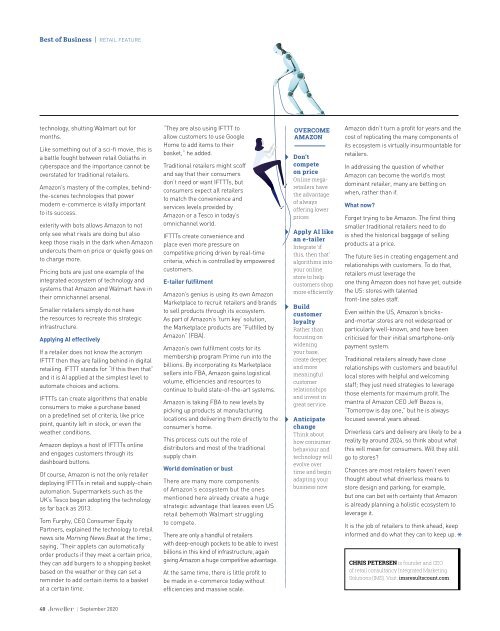Jeweller - September 2020
Best of the bench: Show-stopping pieces from local jewellers Star power: Assessing the value of celebrities and ambassadors in brand marketing Amazon effect: How small businesses can learn from online mega-retailers
Best of the bench: Show-stopping pieces from local jewellers
Star power: Assessing the value of celebrities and ambassadors in brand marketing
Amazon effect: How small businesses can learn from online mega-retailers
You also want an ePaper? Increase the reach of your titles
YUMPU automatically turns print PDFs into web optimized ePapers that Google loves.
Best of Business | RETAIL FEATURE<br />
technology, shutting Walmart out for<br />
months.<br />
Like something out of a sci-fi movie, this is<br />
a battle fought between retail Goliaths in<br />
cyberspace and the importance cannot be<br />
overstated for traditional retailers.<br />
Amazon’s mastery of the complex, behindthe-scenes<br />
technologies that power<br />
modern e-commerce is vitally important<br />
to its success.<br />
exterity with bots allows Amazon to not<br />
only see what rivals are doing but also<br />
keep those rivals in the dark when Amazon<br />
undercuts them on price or quietly goes on<br />
to charge more.<br />
Pricing bots are just one example of the<br />
integrated ecosystem of technology and<br />
systems that Amazon and Walmart have in<br />
their omnichannel arsenal.<br />
Smaller retailers simply do not have<br />
the resources to recreate this strategic<br />
infrastructure.<br />
Applying AI effectively<br />
If a retailer does not know the acronym<br />
IFTTT then they are falling behind in digital<br />
retailing. IFTTT stands for “If this then that”<br />
and it is AI applied at the simplest level to<br />
automate choices and actions.<br />
IFTTTs can create algorithms that enable<br />
consumers to make a purchase based<br />
on a predefined set of criteria, like price<br />
point, quantity left in stock, or even the<br />
weather conditions.<br />
Amazon deploys a host of IFTTTs online<br />
and engages customers through its<br />
dashboard buttons.<br />
Of course, Amazon is not the only retailer<br />
deploying IFTTTs in retail and supply-chain<br />
automation. Supermarkets such as the<br />
UK’s Tesco began adopting the technology<br />
as far back as 2013.<br />
Tom Furphy, CEO Consumer Equity<br />
Partners, explained the technology to retail<br />
news site Morning News Beat at the time:,<br />
saying, “Their applets can automatically<br />
order products if they meet a certain price,<br />
they can add burgers to a shopping basket<br />
based on the weather or they can set a<br />
reminder to add certain items to a basket<br />
at a certain time.<br />
“They are also using IFTTT to<br />
allow customers to use Google<br />
Home to add items to their<br />
basket,” he added.<br />
Traditional retailers might scoff<br />
and say that their consumers<br />
don’t need or want IFTTTs, but<br />
consumers expect all retailers<br />
to match the convenience and<br />
services levels provided by<br />
Amazon or a Tesco in today’s<br />
omnichannel world.<br />
IFTTTs create convenience and<br />
place even more pressure on<br />
competitive pricing driven by real-time<br />
criteria, which is controlled by empowered<br />
customers.<br />
E-tailer fulfilment<br />
Amazon’s genius is using its own Amazon<br />
Marketplace to recruit retailers and brands<br />
to sell products through its ecosystem.<br />
As part of Amazon’s ‘turn key’ solution,<br />
the Marketplace products are “Fulfilled by<br />
Amazon” (FBA).<br />
Amazon’s own fulfilment costs for its<br />
membership program Prime run into the<br />
billions. By incorporating its Marketplace<br />
sellers into FBA, Amazon gains logistical<br />
volume, efficiencies and resources to<br />
continue to build state-of-the-art systems.<br />
Amazon is taking FBA to new levels by<br />
picking up products at manufacturing<br />
locations and delivering them directly to the<br />
consumer’s home.<br />
This process cuts out the role of<br />
distributors and most of the traditional<br />
supply chain.<br />
World domination or bust<br />
There are many more components<br />
of Amazon’s ecosystem but the ones<br />
mentioned here already create a huge<br />
strategic advantage that leaves even US<br />
retail behemoth Walmart struggling<br />
to compete.<br />
There are only a handful of retailers<br />
with deep-enough pockets to be able to invest<br />
billions in this kind of infrastructure, again<br />
giving Amazon a huge competitive advantage.<br />
At the same time, there is little profit to<br />
be made in e-commerce today without<br />
efficiencies and massive scale.<br />
OVERCOME<br />
AMAZON<br />
Don’t<br />
compete<br />
on price<br />
Online megaretailers<br />
have<br />
the advantage<br />
of always<br />
offering lower<br />
prices<br />
Apply AI like<br />
an e-tailer<br />
Integrate ‘if<br />
this, then that’<br />
algorithms into<br />
your online<br />
store to help<br />
customers shop<br />
more efficiently<br />
Build<br />
customer<br />
loyalty<br />
Rather than<br />
focusing on<br />
widening<br />
your base,<br />
create deeper<br />
and more<br />
meaningful<br />
customer<br />
relationships<br />
and invest in<br />
great service<br />
Anticipate<br />
change<br />
Think about<br />
how consumer<br />
behaviour and<br />
technology will<br />
evolve over<br />
time and begin<br />
adapting your<br />
business now<br />
Amazon didn’t turn a profit for years and the<br />
cost of replicating the many components of<br />
its ecosystem is virtually insurmountable for<br />
retailers.<br />
In addressing the question of whether<br />
Amazon can become the world’s most<br />
dominant retailer, many are betting on<br />
when, rather than if.<br />
What now?<br />
Forget trying to be Amazon. The first thing<br />
smaller traditional retailers need to do<br />
is shed the historical baggage of selling<br />
products at a price.<br />
The future lies in creating engagement and<br />
relationships with customers. To do that,<br />
retailers must leverage the<br />
one thing Amazon does not have yet, outside<br />
the US: stores with talented<br />
front-line sales staff.<br />
Even within the US, Amazon’s bricksand-mortar<br />
stores are not widespread or<br />
particularly well-known, and have been<br />
criticised for their initial smartphone-only<br />
payment system.<br />
Traditional retailers already have close<br />
relationships with customers and beautiful<br />
local stores with helpful and welcoming<br />
staff; they just need strategies to leverage<br />
those elements for maximum profit.The<br />
mantra of Amazon CEO Jeff Bezos is,<br />
“Tomorrow is day one,” but he is always<br />
focused several years ahead.<br />
Driverless cars and delivery are likely to be a<br />
reality by around 2024, so think about what<br />
this will mean for consumers. Will they still<br />
go to stores?<br />
Chances are most retailers haven’t even<br />
thought about what driverless means to<br />
store design and parking, for example,<br />
but one can bet with certainty that Amazon<br />
is already planning a holistic ecosystem to<br />
leverage it.<br />
It is the job of retailers to think ahead, keep<br />
informed and do what they can to keep up.<br />
CHRIS PETERSEN is founder and CEO<br />
of retail consultancy Integrated Marketing<br />
Solutions (IMS). Visit: imsresultscount.com<br />
48 | <strong>September</strong> <strong>2020</strong>


















